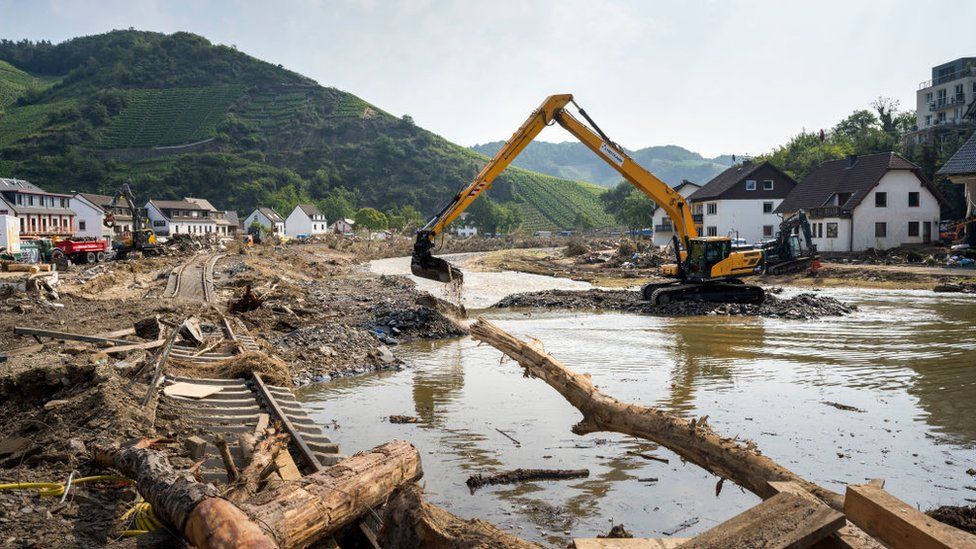Climate change: Europe's extreme rains made more likely by humans
- Published
- comments

The heavy rainfall behind deadly flooding in Europe in July was made more likely by climate change, scientists say.
The floods in Germany, Belgium and other areas killed at least 220 people as towns and villages were swamped.
Researchers say global heating made rainfall events like this up to nine times more likely in Western Europe.
Downpours in the region are 3-19% more intense because of human induced warming.
The dramatic and deadly floods that hit Germany, Belgium and elsewhere in mid-July were a shock to weather forecasters and local authorities.
Lives were swept away and houses, motorways and railway lines destroyed by the rapidly rushing waters.
The severe flooding was caused by heavy rainfall over a period of 1-2 days on already sodden ground, combined with local hydrological factors such as land cover and infrastructure.
To analyse the impact of climate change in events like this, researchers from the World Weather Attribution group focused on the heavy rainfall that preceded the floods.
They did this in part because some of the hydrological monitoring systems, which would have given them more accurate information about the floods, were destroyed by the waters.
The rainfall data showed that in the areas around the Ahr and Erft rivers in Germany and in the Meuse region of Belgium, intense downpours brought 90mm of rain in a single day.
Drone footage shows flood damage in Germany and Belgium
While the scientists found a trend of increasing rainfall in these small regions, making a deduction about the influence of climate change was challenging, as there was also a large amount of natural variability from year to year in the local rainfall patterns.
To really see the influence of rising temperatures, the researchers had to broaden their analysis and look at a larger section of Western Europe, including eastern France, western Germany, eastern Belgium, the Netherlands, Luxembourg and northern Switzerland.
The team found that in this broad region, climate change driven by humans increased the intensity of rain that fell in a one day event in Summer by between 3% and 19%.
Rising temperatures also made downpours similar to those that triggered the floods more likely to happen by a factor of between 1.2 and 9.
Most rapid attribution studies to date have been carried out on extreme heat events such as the recent US and Canadian wildfires. Working on extreme rainfall events is more of a challenge.
"We combined the knowledge of specialists from several fields of study to understand the influence of climate change on the terrible flooding last month, and to make clear what we can and can not analyse in this event," said Dr Sjoukje Philip who's a climate researcher, with the Royal Dutch Meteorological Institute (KNMI) and part of the WWA team.
"It is difficult to analyse the climate change influence on heavy rainfall at very local levels, but we were able to show that, in Western Europe, greenhouse gas emissions have made events like these more likely."
The researchers say that in the current climate, for any given location in Western Europe, they would expect a rainfall event like the one in July to happen once in 400 years.
With continued greenhouse gas emissions and rising temperatures, the heavy rainfall that brought misery to parts of Europe will become more common.
"Our state of the art climate models indicate increases in slow moving extreme rainfall events in a future warmer world," said Professor Hayley Fowler from Newcastle University.
"This event starkly shows how societies are not resilient to current weather extremes. We must reduce greenhouse gas emissions as quickly as possible, as well as improving emergency warning and management systems and making our infrastructure 'climate resilient' - to reduce casualties and costs and make them more able to withstand these extreme flooding events."
The study, which used peer reviewed methods, was carried out by 39 researchers. It can be found here.
Follow Matt on Twitter @mattmcgrathbbc.